Brecknockshire: Difference between revisions
mNo edit summary |
|||
| (19 intermediate revisions by 3 users not shown) | |||
| Line 2: | Line 2: | ||
|name=Brecknockshire | |name=Brecknockshire | ||
|welsh=Sir Frycheiniog | |welsh=Sir Frycheiniog | ||
|map image= | |map image=Brecknockshire Brit Isles Sect 5.svg | ||
|picture= Corn Du from Pen Y Fan - geograph.org.uk - 140882.jpg | |picture=Corn Du from Pen Y Fan - geograph.org.uk - 140882.jpg | ||
|picture caption=Pen y Fan | |picture caption=Pen y Fan | ||
|county town=[[Brecon]] | |county town=[[Brecon]] | ||
|flower= | |||
}} | }} | ||
The '''County of Brecknock''' or '''Brecon''' is a [[Counties of the United Kingdom|shire]] in the mountains of Mid-Wales. | |||
==Geography== | |||
[[File:Old Brecon County signpost - geograph.org.uk - 232881.jpg|250px|thumb|Brecon County signpost to the south-west of Builth Wells]] | |||
Brecknockshire is an inland county bounded to the north by [[Radnorshire]], to the east by [[Herefordshire]] and [[Monmouthshire]], to the south by Monmouthshire and [[Glamorgan]], and to the west by [[Carmarthenshire]] and [[Cardiganshire]]. | |||
{{ | The county is predominantly rural and mountainous. The [[Black Mountains]] occupy the south-east of the county, the [[Brecon Beacons]] the central region, [[Fforest Fawr]] the south-west and [[Mynydd Eppynt]] the north. Most of the Brecon Beacons National Park lies within the county. The highest point is [[Pen-y-Fan]] at 2,907 feet. The River Wye traces nearly the whole of the northern border, and the [[River Usk]] flows in an easterly direction through the central valley. The [[Gospel Pass]], the high road pass at the scarp edge of the mountains, at the head of the [[Vale of Ewyas]] in the Black Mountains, is one of the most spectacular drives in the land. Of the many waterfalls in the county, Henrhyd Falls are particularly spectacular. | ||
The main towns are [[Brecon]], [[Brynmawr]], [[Builth Wells]], [[Hay-on-Wye]], [[Llanwrtyd Wells]] and [[Ystradgynlais]]. The most important industries are agriculture, forestry and tourism. Hay-on-Wye is famed as a "book town", with a far great density of second-hand bookshops, many of great size, than in any other town in the country. | |||
==History== | |||
===Brycheiniog=== | |||
'''Brycheiniog''' was a small, independent petty kingdom in the Early Middle Ages, approximating to today's Brecknockshire, the county taking its name from the kingdom. Brycheiniog often acted as a buffer state between the English to the east and the powerful south Welsh kingdom of Deheubarth to the west. It was conquered and pacified by the Normans between 1088 and 1095 and transformed into the Lordship of Brecon. To its south was the Kingdom of Morgannwg; [[Glamorgan]]. | |||
Brycheiniog was probably founded by Irish raiders in the late fifth century; the oral tradition was that the kingdom was founded by a Hiberno-Welsh prince named Brychan out of the old Welsh kingdom of Garth Madrun in the mid-5th century. Brychan was a son of Anlach, an Irish settler who had peacefully taken control of the area by marrying Marchel, the heiress of Garth Madrun. Brychan's eldest son, Rhain Dremrudd, founded a dynasty which ruled the kingdom uninterrupted until the mid-7th century. | |||
In the 7th century, the kingdom was inherited by Ceindrych; she married Cloten of Dyfed, uniting the kingdoms for about a century until Seisyll of Ceredigion invaded in the mid 8th century and separated Brycheiniog from Dyfed. In the 880s, King Elisedd of Brycheiniog gave homage to Alfred the Great, King of the English, an alliance made in a time predations from Gwynedd and from Vikings; in the spring of 896 Brycheiniog, Gwent and Gwynllwg were devastated by the Norsemen who had wintered at [[Bridgnorth]] that year, while Asser, Alfred's Welsh chaplain and biographer, wrote that Elisedd of Brycheiniog was under pressure from an expansionist Gwynedd. | |||
Brycheiniog was always in the midst of troublesome neighbours and at risk of retaliation; in the early summer of 916 Queen Æthelflaed, Lady of the Mercians and the daughter of King Alfred, invaded Brycheiniog and on 19 June stormed the royal ''llys'' in ''Brecenanmere'' ([[Llangorse Lake]]). There, Welsh chronicles tell us, she captured the queen of the land and 34 others. The king is not identified, but the English Chronicles call him Clydog. The last recorded king of Brycheiniog was Tewdwr ab Elise, who witnessed a charter at the English royal court in 934. Brycheiniog was divided between the three sons of Gruffudd of Brycheiniog in the mid-eleventh century. | |||
===Lordship=== | |||
The land of Brycheiniog was conquered between 1070 and 1093. In 1070 William FitzOsbern, 1st Earl of Hereford invaded the land and defeated three kings of South Wales. By 1088 Bernard de Neufmarché held a lordship in Brycheiniog and in April 1093, while building a castle at [[Brecon]], he defeated and killed the King of [[Deheubarth]], Rhys ap Tewdwr. The lordship of [[Brecon]] remained ruled by Bernard's descendants.<ref name="NSW">{{cite web | last=Nelson | first=Lynn H. | title=The Normans in South Wales | work=Carrie: A Full-Text Electronic Library | url=http://vlib.iue.it/carrie/texts/carrie_books/nelson/index.html | year=1966 | accessdate=2007-08-21}}</ref> | |||
During the reign of Llywelyn ap Gruffydd of Gwynedd the homage of the Lord of Brycheiniog was transferred to him from the King of England (Henry III) by the Treaty of Montgomery in 1267. However, it was an attack on Brycheiniog by the ''Marcher Lords'' Humphrey de Bohun and Roger Mortimer in 1276 which led to the final breakdown of the peace, after which Llywelyn's domain was reduced to just his lands in Gwynedd. Brycheiniog was thereafter subject to the King of England. | |||
===Shire=== | |||
The Laws in Wales Act 1535 created the County or Shire of Brecknock by combining a number of "lordships, towns, parishes, commotes and cantreds" in the "Country or Dominion of Wales''. The areas combined were: | |||
"Brekenoke" (Brecknock), "Crekehowell" ([[Crickhowell]]) "Tretowre", "Penkelly", "Englisshe Talgarth", "Welsshe Talgarth", "Dynas", "The Haye" ([[Hay-on-Wye]]), "Glynebogh", "Broynlles", "Cantercely", "Llando Blaynllynby", "Estrodewe", "Buelthe" ([[Builth]]), and "Llangors". The town of Brecknock or [[Brecon]] was declared the county town.<ref>{{cite web |url=http://www.statutelaw.gov.uk/content.aspx?activeTextDocId=1517920&versionNumber=1 |title=Laws in Wales Act 1535 |accessdate=2008-07-26 |author=|date=|work=UK Law Statute Database |publisher=Ministry of Justice}}</ref> | |||
==Hundreds== | |||
[[File:Brecknockshire Hundreds.svg|thumb|250px|The hundreds of Brecknockshire]] | |||
Brecknockshire is divided into six hundreds: | |||
{| | |||
| | |||
*[[Builth Hundred|Builth]] | |||
*[[Crickhowell Hundred|Crickhowell]] | |||
*[[Devynnock Hundred|Devynnock]] | |||
| | |||
*[[Merthyr Hundred|Merthyr]] | |||
*[[Penkelly Hundred|Penkelly]] | |||
*[[Talgarth Hundred|Talgarth]] | |||
|} | |||
==Towns and villages== | |||
[[File:Brecon shopping centre.jpg|right|thumb|250px|Brecon]] | |||
[[File:Hay on Wye Bookshop2.JPG|right|thumb|250px|Hay-on-Wye]] | |||
*[[Brecon]] - ''(county town)'' | |||
*[[Brynmawr]] | |||
*[[Builth Wells]] | |||
*[[Hay-on-Wye]] | |||
*[[Llanwrtyd Wells]] | |||
*[[Ystradgynlais]] | |||
===Civil communities=== | |||
{{parishliststart}} | |||
*[[Beaufort]] | |||
*[[Brecon]] | |||
*[[Bronllys]] | |||
*[[Brynmawr]] | |||
*[[Builth Wells]] | |||
*[[Cilmery]] | |||
*[[Cray]] | |||
*[[Crickhowell]] | |||
*[[Cwmdu and District]] | |||
*[[Duhonw]] | |||
*[[Erwood]] | |||
*[[Felinfach, Brecknockshire|Felinfach]] | |||
*[[Glyn Tarrell]] | |||
*[[Gwernyfed]] | |||
*[[Hay-on-Wye]] | |||
*[[Honddu Isaf]] | |||
*[[Llanafan-fawr]] | |||
*[[Llanddew]] | |||
*[[Llanelly]] | |||
*[[Llanfrynach]] | |||
*[[Llangammarch]] | |||
*[[Llangattock]] | |||
*[[Llangors]] | |||
*[[Llangynidr]] | |||
*[[Llanigon]] | |||
*[[Llanwrthwl]] | |||
*[[Llanwrtyd Wells]] | |||
*[[Llywel]] | |||
*[[Maescar]] | |||
*[[Merthyr Cynog]] | |||
*[[Rassau]] | |||
*[[Talgarth]] | |||
*[[Talybont-on-Usk]] | |||
*[[Tawe Uchaf]] | |||
*[[Trallong]] | |||
*[[Treflys]] | |||
*[[Vale of Grwyney]] | |||
*[[Vaynor]] | |||
*[[Ysgir]] | |||
*[[Ystradfellte]] | |||
*[[Ystradgynlais]] | |||
{{parishlistend}} | |||
==Transport== | |||
===Road=== | |||
The A40 London-Fishguard trunk road passes in an east-west direction through the south of the county and the A483 Swansea-Manchester trunk road passes through the north. The A470 Cardiff-Glan Conway trunk road enters the county north of [[Merthyr Tydfil]] and after meeting the A40 at Brecon hugs the eastern border until it leaves the county just south of [[Rhayader]]. | |||
===Rail=== | |||
The Heart of Wales railway line follows a similar route to the A483 through the north of the county, with stops at Sugar Loaf, Llanwrtyd Wells, Llangammarch Wells, and Cilmeri. Builth Road station to the north of Builth Wells is situated in [[Radnorshire]]. The south of the county once had an extensive rail network with connections through [[Glamorgan]] and [[Monmouthshire]] to [[Neath]], [[Merthyr Tydfil]], [[Cardiff]], [[Newport, Monmouthshire|Newport]] and thence to the main Great Western main line. | |||
==Things to see in Brecknockshire== | |||
[[File:Lllangorse lake from llangorse mountain.jpg|right|thumb|250px|Llangorse Lake]] | |||
{{UKPlacesKey}} | |||
===Built heritage=== | |||
*{{i-Museum}} Brecknock Museum, [[Brecon]], | |||
*{{i-Cathedral}} [[Brecon Cathedral]] | |||
*{{i-Castle}} [[Castell Du]] | |||
*[[Hay-on-Wye]] book town | |||
*{{i-Castle}} [[Tretower Castle]] and [[Tretower Court]] | |||
*[[Y Gaer]] Roman fort, Brecon | |||
===Natural landscape=== | |||
[[File:Brecon beacons arp.jpg|thumb|250px|Cribyn, from Pen-y-Fan]] | |||
*[[Black Mountains]] | |||
*[[Brecon Beacons]] | |||
*[[Dan-yr-Ogof Caves]], Glyntawe | |||
*[[Llangorse Lake]] | |||
*[[Ogof Agen Allwedd]] cave system | |||
*[[Ogof Craig a Ffynnon]] cave system | |||
*[[Ogof Ffynnon Ddu]] cave system | |||
*[[Ogof y Daren Cilau]] cave system | |||
==See also== | |||
[[Flag of Brecknockshire]] | |||
==References== | |||
{{reflist}} | |||
===Historical References=== | |||
* Remfry, P.M., ''Castell Bwlch y Dinas and the Families of Fitz Osbern, Neufmarché, Gloucester, Hereford, Braose, Fitz Herbert'' (ISBN 1-899376-79-8) | |||
* Remfry, P.M., ''Annales Cambriae. A Translation of Harleian 3859; PRO E.164/1; Cottonian Domitian, A 1; Exeter Cathedral Library MS. 3514 and MS Exchequer DB Neath, PRO E'' (ISBN 1-899376-81-X) | |||
{{British county}} | {{British county}} | ||
Latest revision as of 11:47, 8 December 2019
| Brecknockshire Welsh: Sir Frycheiniog United Kingdom | |
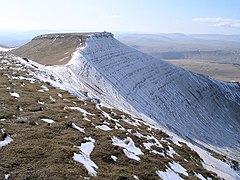 Pen y Fan | |
|---|---|
| Undeb Hedd Llwyddiant (Unity, peace, prosperity) | |
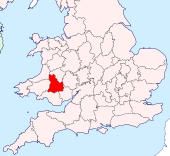
| |
| [Interactive map] | |
| Area: | 742 square miles |
| Population: | 67,598 |
| County town: | Brecon |
| County flower: | Cuckoo flower [1] |
The County of Brecknock or Brecon is a shire in the mountains of Mid-Wales.
Geography
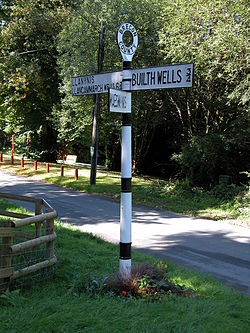
Brecknockshire is an inland county bounded to the north by Radnorshire, to the east by Herefordshire and Monmouthshire, to the south by Monmouthshire and Glamorgan, and to the west by Carmarthenshire and Cardiganshire.
The county is predominantly rural and mountainous. The Black Mountains occupy the south-east of the county, the Brecon Beacons the central region, Fforest Fawr the south-west and Mynydd Eppynt the north. Most of the Brecon Beacons National Park lies within the county. The highest point is Pen-y-Fan at 2,907 feet. The River Wye traces nearly the whole of the northern border, and the River Usk flows in an easterly direction through the central valley. The Gospel Pass, the high road pass at the scarp edge of the mountains, at the head of the Vale of Ewyas in the Black Mountains, is one of the most spectacular drives in the land. Of the many waterfalls in the county, Henrhyd Falls are particularly spectacular.
The main towns are Brecon, Brynmawr, Builth Wells, Hay-on-Wye, Llanwrtyd Wells and Ystradgynlais. The most important industries are agriculture, forestry and tourism. Hay-on-Wye is famed as a "book town", with a far great density of second-hand bookshops, many of great size, than in any other town in the country.
History
Brycheiniog
Brycheiniog was a small, independent petty kingdom in the Early Middle Ages, approximating to today's Brecknockshire, the county taking its name from the kingdom. Brycheiniog often acted as a buffer state between the English to the east and the powerful south Welsh kingdom of Deheubarth to the west. It was conquered and pacified by the Normans between 1088 and 1095 and transformed into the Lordship of Brecon. To its south was the Kingdom of Morgannwg; Glamorgan.
Brycheiniog was probably founded by Irish raiders in the late fifth century; the oral tradition was that the kingdom was founded by a Hiberno-Welsh prince named Brychan out of the old Welsh kingdom of Garth Madrun in the mid-5th century. Brychan was a son of Anlach, an Irish settler who had peacefully taken control of the area by marrying Marchel, the heiress of Garth Madrun. Brychan's eldest son, Rhain Dremrudd, founded a dynasty which ruled the kingdom uninterrupted until the mid-7th century.
In the 7th century, the kingdom was inherited by Ceindrych; she married Cloten of Dyfed, uniting the kingdoms for about a century until Seisyll of Ceredigion invaded in the mid 8th century and separated Brycheiniog from Dyfed. In the 880s, King Elisedd of Brycheiniog gave homage to Alfred the Great, King of the English, an alliance made in a time predations from Gwynedd and from Vikings; in the spring of 896 Brycheiniog, Gwent and Gwynllwg were devastated by the Norsemen who had wintered at Bridgnorth that year, while Asser, Alfred's Welsh chaplain and biographer, wrote that Elisedd of Brycheiniog was under pressure from an expansionist Gwynedd.
Brycheiniog was always in the midst of troublesome neighbours and at risk of retaliation; in the early summer of 916 Queen Æthelflaed, Lady of the Mercians and the daughter of King Alfred, invaded Brycheiniog and on 19 June stormed the royal llys in Brecenanmere (Llangorse Lake). There, Welsh chronicles tell us, she captured the queen of the land and 34 others. The king is not identified, but the English Chronicles call him Clydog. The last recorded king of Brycheiniog was Tewdwr ab Elise, who witnessed a charter at the English royal court in 934. Brycheiniog was divided between the three sons of Gruffudd of Brycheiniog in the mid-eleventh century.
Lordship
The land of Brycheiniog was conquered between 1070 and 1093. In 1070 William FitzOsbern, 1st Earl of Hereford invaded the land and defeated three kings of South Wales. By 1088 Bernard de Neufmarché held a lordship in Brycheiniog and in April 1093, while building a castle at Brecon, he defeated and killed the King of Deheubarth, Rhys ap Tewdwr. The lordship of Brecon remained ruled by Bernard's descendants.[1]
During the reign of Llywelyn ap Gruffydd of Gwynedd the homage of the Lord of Brycheiniog was transferred to him from the King of England (Henry III) by the Treaty of Montgomery in 1267. However, it was an attack on Brycheiniog by the Marcher Lords Humphrey de Bohun and Roger Mortimer in 1276 which led to the final breakdown of the peace, after which Llywelyn's domain was reduced to just his lands in Gwynedd. Brycheiniog was thereafter subject to the King of England.
Shire
The Laws in Wales Act 1535 created the County or Shire of Brecknock by combining a number of "lordships, towns, parishes, commotes and cantreds" in the "Country or Dominion of Wales. The areas combined were: "Brekenoke" (Brecknock), "Crekehowell" (Crickhowell) "Tretowre", "Penkelly", "Englisshe Talgarth", "Welsshe Talgarth", "Dynas", "The Haye" (Hay-on-Wye), "Glynebogh", "Broynlles", "Cantercely", "Llando Blaynllynby", "Estrodewe", "Buelthe" (Builth), and "Llangors". The town of Brecknock or Brecon was declared the county town.[2]
Hundreds
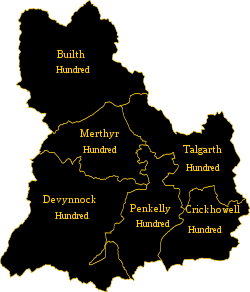
Brecknockshire is divided into six hundreds:
Towns and villages
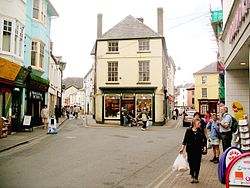
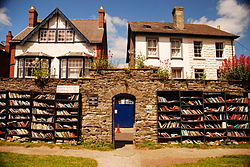
- Brecon - (county town)
- Brynmawr
- Builth Wells
- Hay-on-Wye
- Llanwrtyd Wells
- Ystradgynlais
Civil communities
- Beaufort
- Brecon
- Bronllys
- Brynmawr
- Builth Wells
- Cilmery
- Cray
- Crickhowell
- Cwmdu and District
- Duhonw
- Erwood
- Felinfach
- Glyn Tarrell
- Gwernyfed
- Hay-on-Wye
- Honddu Isaf
- Llanafan-fawr
- Llanddew
- Llanelly
- Llanfrynach
- Llangammarch
- Llangattock
- Llangors
- Llangynidr
- Llanigon
- Llanwrthwl
- Llanwrtyd Wells
- Llywel
- Maescar
- Merthyr Cynog
- Rassau
- Talgarth
- Talybont-on-Usk
- Tawe Uchaf
- Trallong
- Treflys
- Vale of Grwyney
- Vaynor
- Ysgir
- Ystradfellte
- Ystradgynlais
Transport
Road
The A40 London-Fishguard trunk road passes in an east-west direction through the south of the county and the A483 Swansea-Manchester trunk road passes through the north. The A470 Cardiff-Glan Conway trunk road enters the county north of Merthyr Tydfil and after meeting the A40 at Brecon hugs the eastern border until it leaves the county just south of Rhayader.
Rail
The Heart of Wales railway line follows a similar route to the A483 through the north of the county, with stops at Sugar Loaf, Llanwrtyd Wells, Llangammarch Wells, and Cilmeri. Builth Road station to the north of Builth Wells is situated in Radnorshire. The south of the county once had an extensive rail network with connections through Glamorgan and Monmouthshire to Neath, Merthyr Tydfil, Cardiff, Newport and thence to the main Great Western main line.
Things to see in Brecknockshire
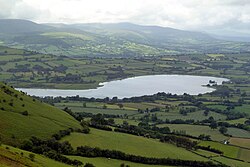
| Key | |
| Cathedral/Abbey/Priory | |
| Accessible open space | |
| Amusement/Theme Park | |
| Castle | |
| Country Park | |
| Cadw | |
| Forestry Commission | |
| Heritage railway | |
| Historic House | |
| Museum (free/not free) | |
| National Trust | |
| Zoo | |
Built heritage
 Brecknock Museum, Brecon,
Brecknock Museum, Brecon, Brecon Cathedral
Brecon Cathedral Castell Du
Castell Du- Hay-on-Wye book town
 Tretower Castle and Tretower Court
Tretower Castle and Tretower Court- Y Gaer Roman fort, Brecon
Natural landscape
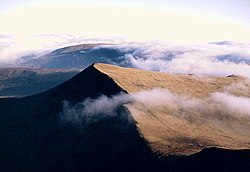
- Black Mountains
- Brecon Beacons
- Dan-yr-Ogof Caves, Glyntawe
- Llangorse Lake
- Ogof Agen Allwedd cave system
- Ogof Craig a Ffynnon cave system
- Ogof Ffynnon Ddu cave system
- Ogof y Daren Cilau cave system
See also
References
- ↑ Nelson, Lynn H. (1966). "The Normans in South Wales". Carrie: A Full-Text Electronic Library. http://vlib.iue.it/carrie/texts/carrie_books/nelson/index.html. Retrieved 2007-08-21.
- ↑ "Laws in Wales Act 1535". UK Law Statute Database. Ministry of Justice. http://www.statutelaw.gov.uk/content.aspx?activeTextDocId=1517920&versionNumber=1. Retrieved 2008-07-26.
Historical References
- Remfry, P.M., Castell Bwlch y Dinas and the Families of Fitz Osbern, Neufmarché, Gloucester, Hereford, Braose, Fitz Herbert (ISBN 1-899376-79-8)
- Remfry, P.M., Annales Cambriae. A Translation of Harleian 3859; PRO E.164/1; Cottonian Domitian, A 1; Exeter Cathedral Library MS. 3514 and MS Exchequer DB Neath, PRO E (ISBN 1-899376-81-X)
| Counties of the United Kingdom |
|---|
|
Aberdeen • Anglesey • Angus • Antrim • Argyll • Armagh • Ayr • Banff • Bedford • Berks • Berwick • Brecknock • Buckingham • Bute • Caernarfon • Caithness • Cambridge • Cardigan • Carmarthen • Chester • Clackmannan • Cornwall • Cromarty • Cumberland • Denbigh • Derby • Devon • Dorset • Down • Dumfries • Dunbarton • Durham • East Lothian • Essex • Fermanagh • Fife • Flint • Glamorgan • Gloucester • Hants • Hereford • Hertford • Huntingdon • Inverness • Kent • Kincardine • Kinross • Kirkcudbright • Lanark • Lancaster • Leicester • Lincoln • Londonderry • Merioneth • Middlesex • Midlothian • Monmouth • Montgomery • Moray • Nairn • Norfolk • Northampton • Northumberland • Nottingham • Orkney • Oxford • Peebles • Pembroke • Perth • Radnor • Renfrew • Ross • Roxburgh • Rutland • Selkirk • Shetland • Salop • Somerset • Stafford • Stirling • Suffolk • Surrey • Sussex • Sutherland • Tyrone • Warwick • West Lothian • Westmorland • Wigtown • Wilts • Worcester • York |